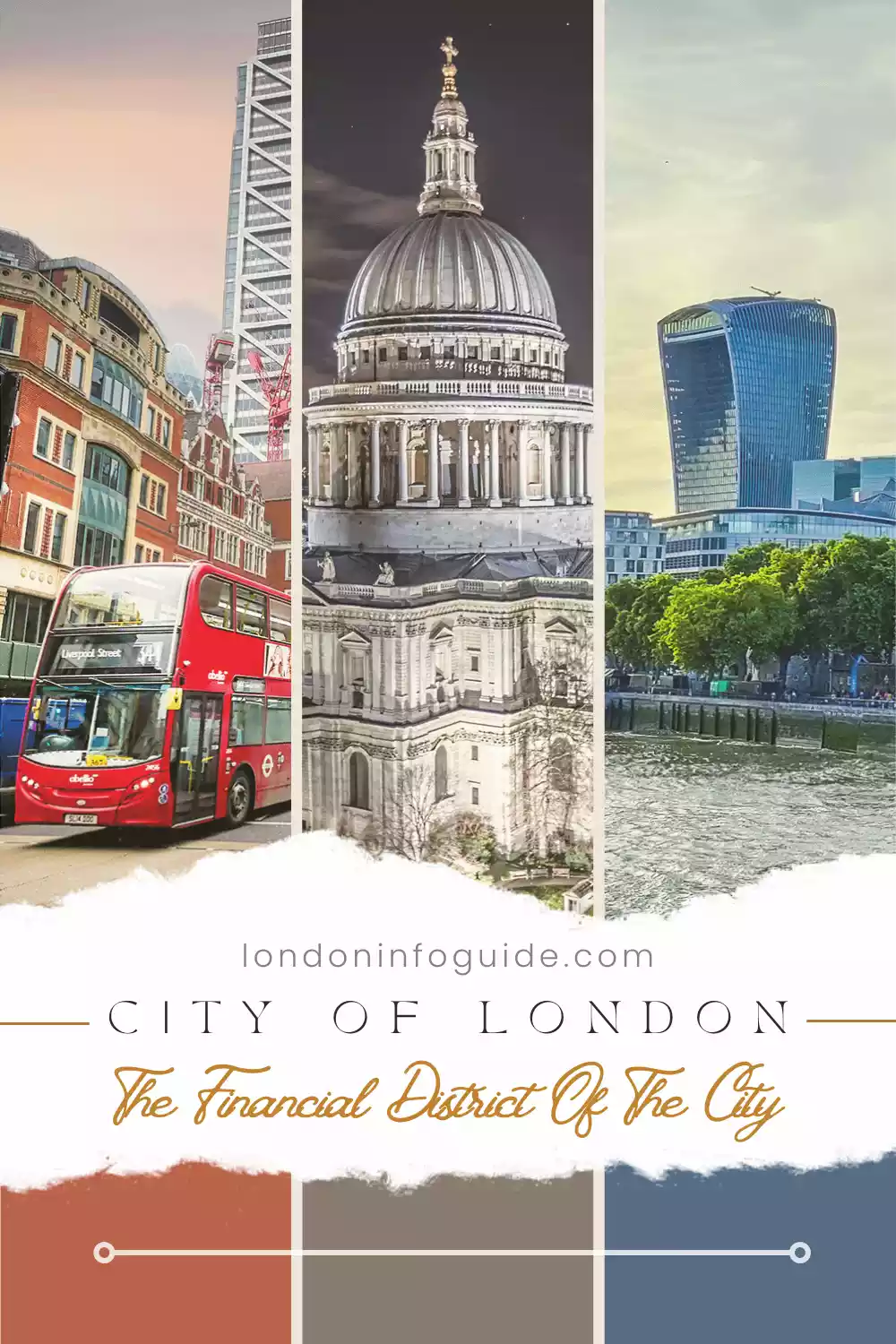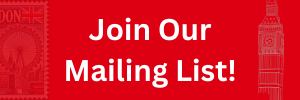- Home
- Best Areas in London
- The City of London England
the city of london england
The Financial District of London
The City of London England is a city with centuries of history, a fusion of tradition, innovation and unending charm that is an effervescent fusion of tradition, innovation, and unending charm that reflects past centuries. Our guide is designed to give you all the information you need about how to visit the city, what to do, where to stay, facts, famous landmarks, and common questions people ask about the city to make your visit the best it can be.
table of contents - the city of london england
- Where To Stay in the City of London
- Things to do in the City of London
- Best Restaurants in the City of London
- Historical Facts About the City of London
- How To Get To City of London England
- Map of the City of London
- Common Questions About City of London
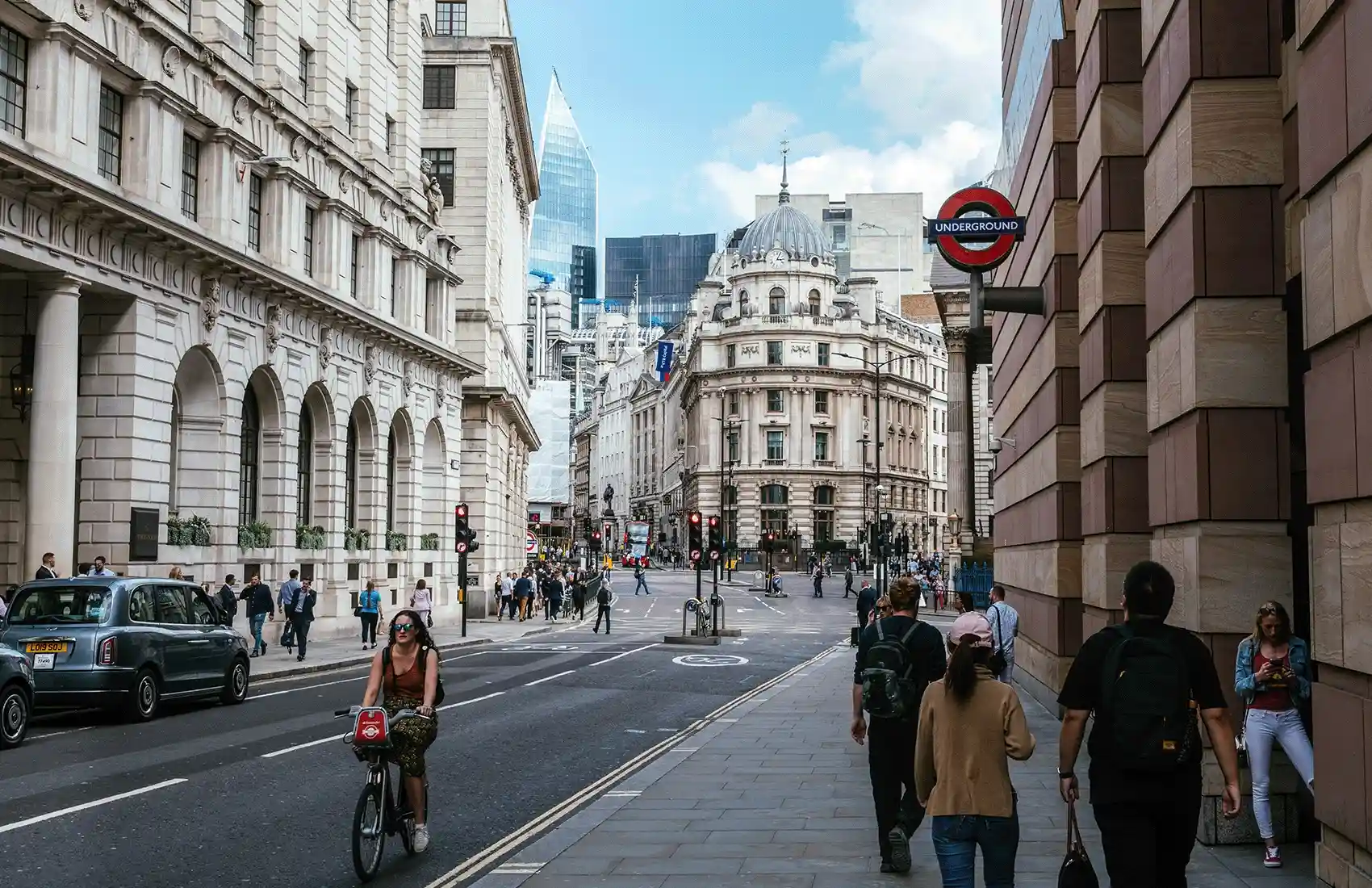 Streets of the City of London England
Streets of the City of London Englandwhere to stay in the city of london
Staying in the City of London can be advantageous if you are looking for convenience, networking opportunities, and easy access to financial institutions and historical landmarks. However, your preferences and the purpose of your visit should guide your choice of accommodation in London.
However, it is essential to note that accommodation in this area might be relatively expensive due to its central location and proximity to business institutions. Still, you will find a range of accommodations, from luxurious 5-star hotels to comfortable 3 to 4-star options, offering diverse choices for every budget.
Check out other areas in London where to stay.
🎅 London Christmas Planning 2025 Starts Now!
- 🏨 Best Hotels in London for Christmas
- 🎄 Christmas in London Guide: Events | Lights | Markets | Tours
- ✨ Best Areas to Stay in London
- 🎁 Luxury Hotels in London
- ❄️ Weather In London For Christmas
- 🎟️ Things to Do in London in December
- 🛍️ Shopping in London at Christmas 2025
- 🎡 Visit Winter Wonderland at Hyde Park in London
- 🏨 Best Hotels Close to Winter Wonderland
Things to do in the city of london
We have compiled a list of what to do within the confines of the City of London from iconic landmarks to vibrant markets.
Family-friendly attractions around the area
St. Paul's Cathedral: Experience the magnificent architecture of St. Paul's Cathedral, climb to the top of the dome for an amazing view of London, and learn about the cathedral's significance to British culture and history.
The City of London Museum: With interactive exhibits, artefacts, and exhibitions, experience London's rich history from ancient times to the present day at the City of London Museum.
The Postal Museum: Discover the fascinating history of the British postal system at the Postal Museum, which contains exhibits on postage, letters, and innovative mail transportation methods.
Thames River Walk: Stroll along the River Thames, taking in the views of Shakespeare's Globe Theatre and Tower Bridge, and soaking up the lively ambience of the riverside.
Bank of England Museum: Explore the interesting history of banking, browse old banknotes, and engage in interactive exhibitions at the Bank of England Museum.
Sky Garden: This beautiful and unusually looking Sky Garden provides restaurants, observation decks, lush foliage, and stunning panoramic views perched atop the "Walkie-Talkie" skyscraper.
London Wall: Ruins of the ancient defence wall that surrounded Londinium in Roman times; reveal the fascinating history of the city.
The Monument to the Great Fire of London: It is one of the most historic columns in London and was built to commemorate the Great Fire of 1666. Climbers can climb the monument for a fantastic view of the city.
Related Hotel Guides: South Bank | Mayfair | Covent Garden | Soho | Paddington | Paddington Station | Marylebone | Westminster | Near the London Eye, Tower Bridge, Buckingham Palace, Wimbledon Stadium | Luxury Hotels | Marriott Hotels | Christmas Hotels
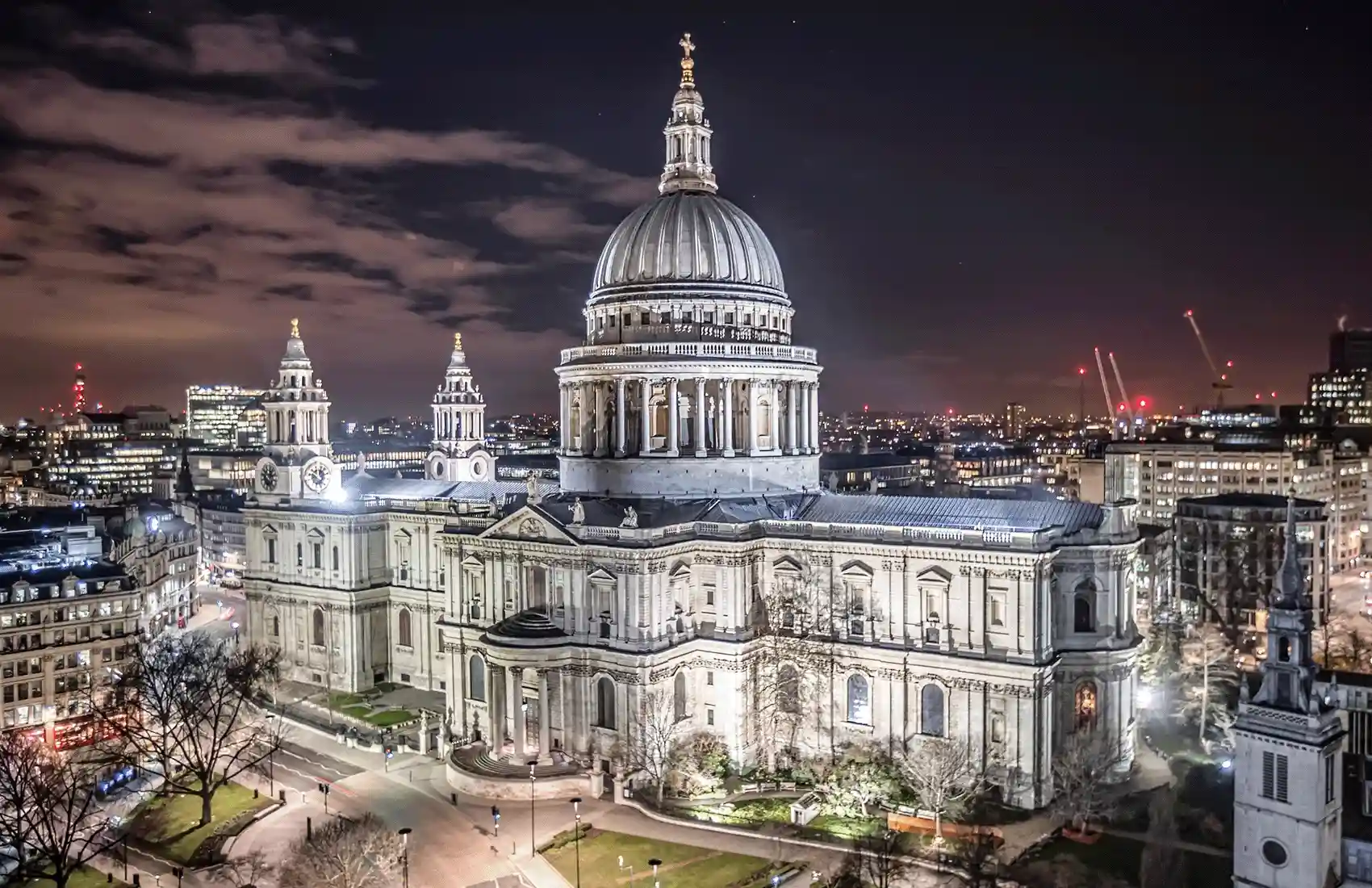 St. Paul's Cathedral London
St. Paul's Cathedral LondonMarkets around city of london UK
Leadenhall Market: There are a wide variety of shops, eateries, and specialised businesses in this ancient covered market in Lime Street Ward.
One New Change: There are many high-street and designer boutiques at this contemporary shopping attraction near St. Paul's Cathedral.
Smithfield Market: Fresh meat, poultry, and gourmet culinary items are available in this historic meat market in Smithfield.
The Royal Exchange: Located near Bank and Monument stations, this upscale shopping destination offers elegant dining, boutiques, and a historic shopping experience.
Discover the various other markets London has to offer.
Theatres in The city of london
Barbican Centre: It offers a variety of performances, including dance performances, concerts, musicals, and plays. Performances of Shakespearean plays, contemporary dance pieces, and classical concerts have all been noteworthy.
Bridewell Theatre: A vibrant performance venue, this location hosts a variety of different productions throughout the year. It hosts plays, musicals, and artistic performances, contributing to the cultural life of the city.
Guildhall School of Music & Drama: The school focuses primarily on teaching music and performing arts, but occasionally hosts public concerts, usually featuring classical music recitals and student productions.
related page: check out other areas around london to visit
explore attractions beyond the city of london's core
Take a look at what is beyond the boundaries of the City of London England. The below attractions stand close to the district offering an enriching experience.
Tower of London: Experience centuries of fascinating tales at the Tower of London as it has served as a royal residence, a jail, and a treasury over the centuries. There is nothing like seeing the Crown Jewels up close.
Tower Bridge: Stroll along its high-level walkways, stop by the Victorian Engine Rooms, and learn about its history through interactive displays. [1] The City Bridge Foundation oversees the running of Tower Bridge, with the City of London Corporation serving as the sole trustee.
Tate Modern: An intriguing tourist destination that provides a wide range of centuries-spanning cultural activities, exhibitions, and art collections. situated across from the Millennium Bridge
The Shard: Locals and tourists alike love its famed skyline views, expansive observation deck, fine food, and immersive experiences, which offer unrivalled views of the city's splendour.
related page: other things to do in london England
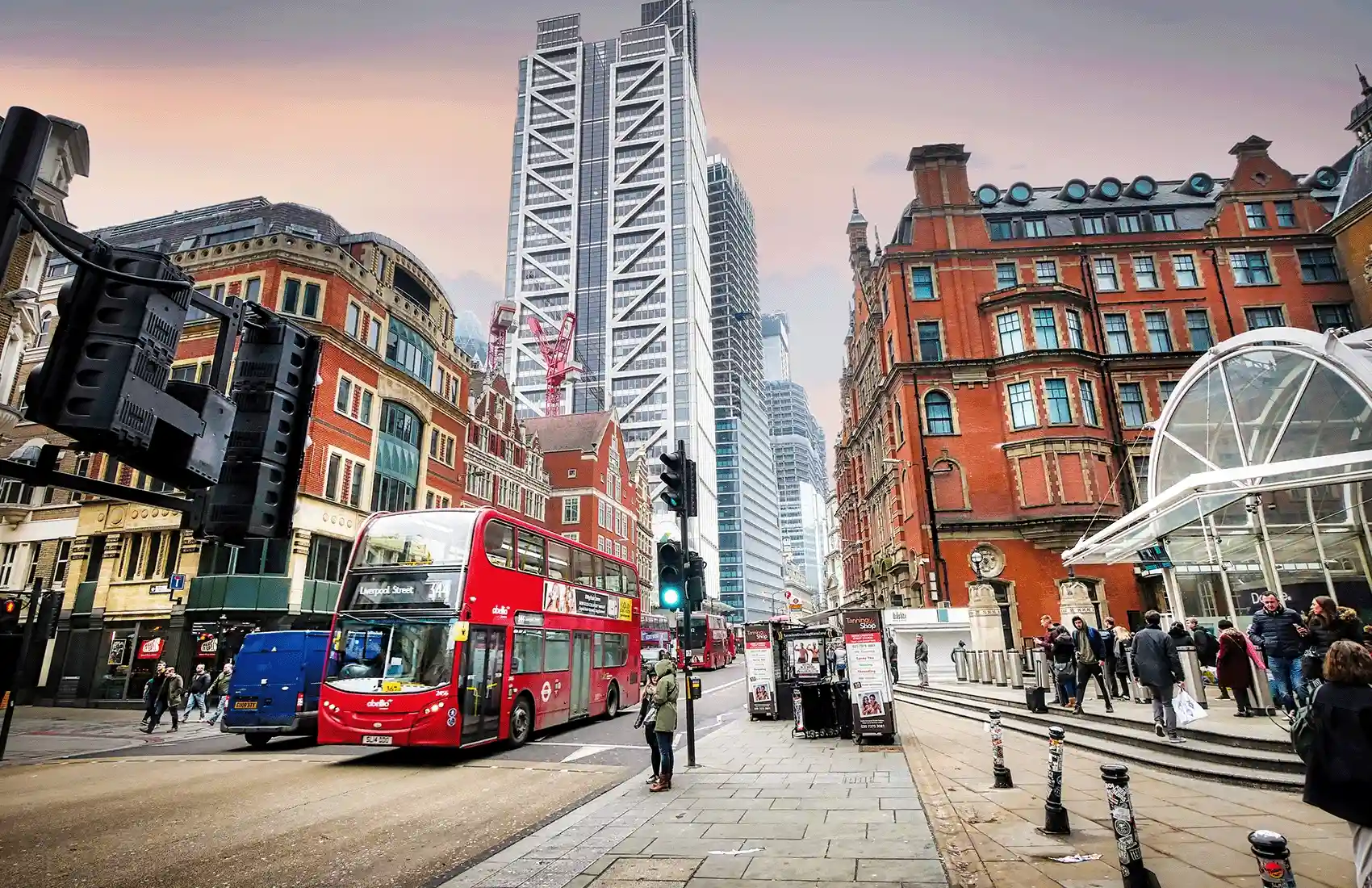 Bishopsgate Street, City of London
Bishopsgate Street, City of LondonBest Restaurants In city of london
Whether craving a quick bite or seeking a delightful dinner, the City of London offers an array of restaurants with diverse cuisines and scenic views. Here are some dining spots to please your palate.
- Duck & Waffle: Located on the 40th level of Heron Tower, this restaurant offers British-European cuisine around the clock. With a variety of tasty dishes in a relaxed yet vibrant atmosphere, the restaurant emulates the charm of its predecessor.
- Darwin Brasserie: It offers contemporary European cuisine and stunning views of London from its location within the renowned Sky Garden.
- Sushisamba: An inventive combination of Brazilian, Peruvian, and Japanese flavours is served in this famous restaurant, perched high above the city.
- Hawksmoor Guildhall: This steakhouse in the heart of the financial district is known for its tantalizing choice of ocean-fresh fish and succulent cuts of beef.
- The Ned: In an elegant and historic location, a magnificent hotel with seven restaurants and three bars serving a variety of cuisines, from British to American.
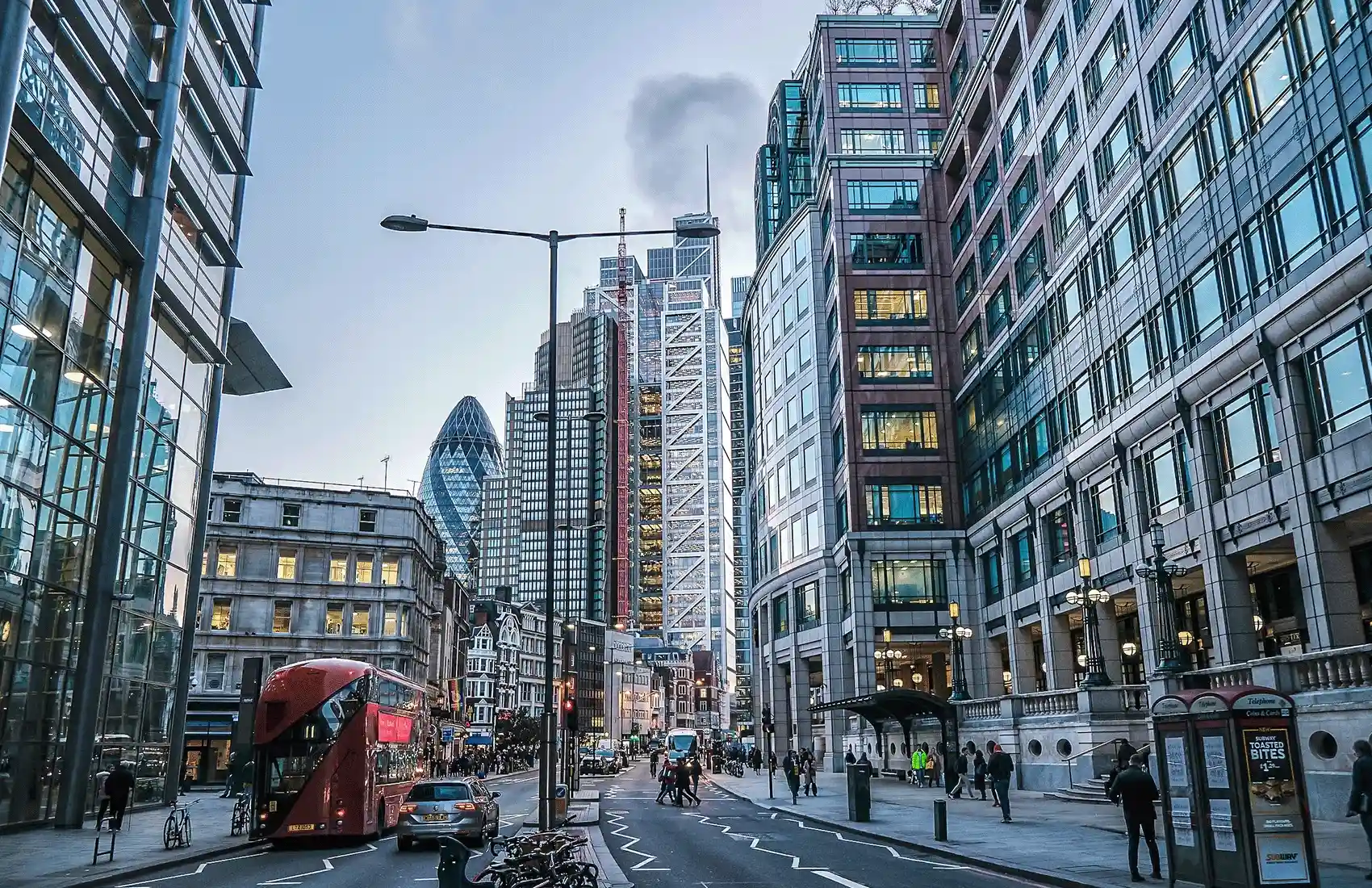 London's Financial District
London's Financial Districthistorical Facts About The city of london
These historical facts highlight the City of London's rich and diverse history, encompassing centuries of significant events, influences, and developments that have shaped its identity and contributed to its global significance.
- Oldest Continuous Democracy: The City of London boasts one of the world's oldest continuously operating elected governments, known as the City of London Corporation, tracing its origins back over a thousand years. [2]
- Great Fire of London: In 1666, a devastating fire ravaged the City of London, destroying a significant portion of the area, including St. Paul's Cathedral. This event led to major reconstruction and the creation of fire safety regulations.
- Roman Origins: The city's history dates back to the Roman era when it was established as the Roman settlement of Londinium around AD 43. Remnants of the Roman wall and archaeological findings still exist today.
- Financial Centre: Recognized as a global financial hub, the City of London has been a centre for trade and finance for centuries, hosting the London Stock Exchange and numerous financial institutions.
- Magna Carta: In 1215, the Magna Carta, an influential document outlining basic rights and freedoms, was agreed upon at Runnymede near the City of London, shaping the foundation of constitutional law.
- Guilds and Livery Companies: Dating back to the medieval period, the City's guilds and livery companies played a crucial role in trade regulation, professional standards, and social support systems.
- St. Paul's Cathedral: The iconic St. Paul's Cathedral, designed by Sir Christopher Wren, replaced the previous cathedral destroyed in the Great Fire. It stands as a symbol of resilience and architectural grandeur.
- The Tower of London: This historic castle and former royal residence, situated within the City, has served various purposes over the centuries, including as a fortress, royal mint, and prison.
- Remnants of History: Throughout the City, visitors can find remnants of historical significance, including ancient churches, medieval alleyways, and hidden gems that hold centuries of stories within their walls.
read more: Explore this go-to guide to southbank london
Iconic Buildings in the Heart of London's City
As cultural landmarks, these iconic buildings hold immense significance within the city, representing not only architectural brilliance but also architectural excellence.
- City University of London: Offers a wide range of courses, a modern campus, and facilities for research in a variety of subject areas.
- The Bank of England: The UK's central bank regulates financial institutions, issues currency, and implements monetary policy.
- Lord Mayor's Offices: Home and administrative centre of the Lord Mayor of London. A focal point for diplomatic visits, events, and civic duties.
- The Gherkin (30 St Mary Axe): This skyscraper is renowned for its unusual architecture and adds to London's famed skyline. The building houses offices, restaurants, and event spaces.
- The Royal Exchange: An elegant shopping destination with fine dining, shopping, and events situated in the historic district.
- Tower 42: Formerly known as NatWest Tower, this skyscraper provides restaurants, office space, and public viewing galleries in London's financial district.
- Guildhall: London's civic and ceremonial hub and a landmark structure of remarkable architecture and cultural significance.
- Lloyd's Building: An architectural marvel that houses Lloyd's insurance market. Known for its futuristic interiors, unique appearance, and high-tech architecture.
City of London's Prominent Personalities
Undoubtedly, a large number of well-known people were either residents of or closely associated with the City of London. Here, we just touch on a few of them.
- Benedict Cumberbatch: The actor often visits London for events or to stay connected to his career.
- David Beckham: The former footballer has ties to London through business events, meetings, and promotions.
- Elon Musk: SpaceX and Tesla CEOs may have stayed in London for conferences or business visits.
- Angelina Jolie: She has been linked to charity events, premieres, and charity endeavours in London.
- Samuel Pepys: The well-known diarist lived in the City of London during the 17th century and wrote about important events, including the Great Fire.
- William Shakespeare: The King's Men performed at the Globe Theatre in the City of London, although this is unconfirmed.
- Christopher Wren: A renowned architect based in the City of London responsible for reconstructing many buildings after the Great Fire. St. Paul's Cathedral is his best-known design.
- Charles Dickens: Known for including locales from the City of London in his novels, Dickens captured the spirit of the Victorian era. His life was spent in various areas of London.
- Benjamin Franklin: A statesman and inventor from the United States, Franklin served as the country's ambassador to England in the City of London.
- Mary Wollstonecraft: Mary Wollstonecraft was a pioneering feminist and writer who resided in the City of London and worked there during the late 1700s.
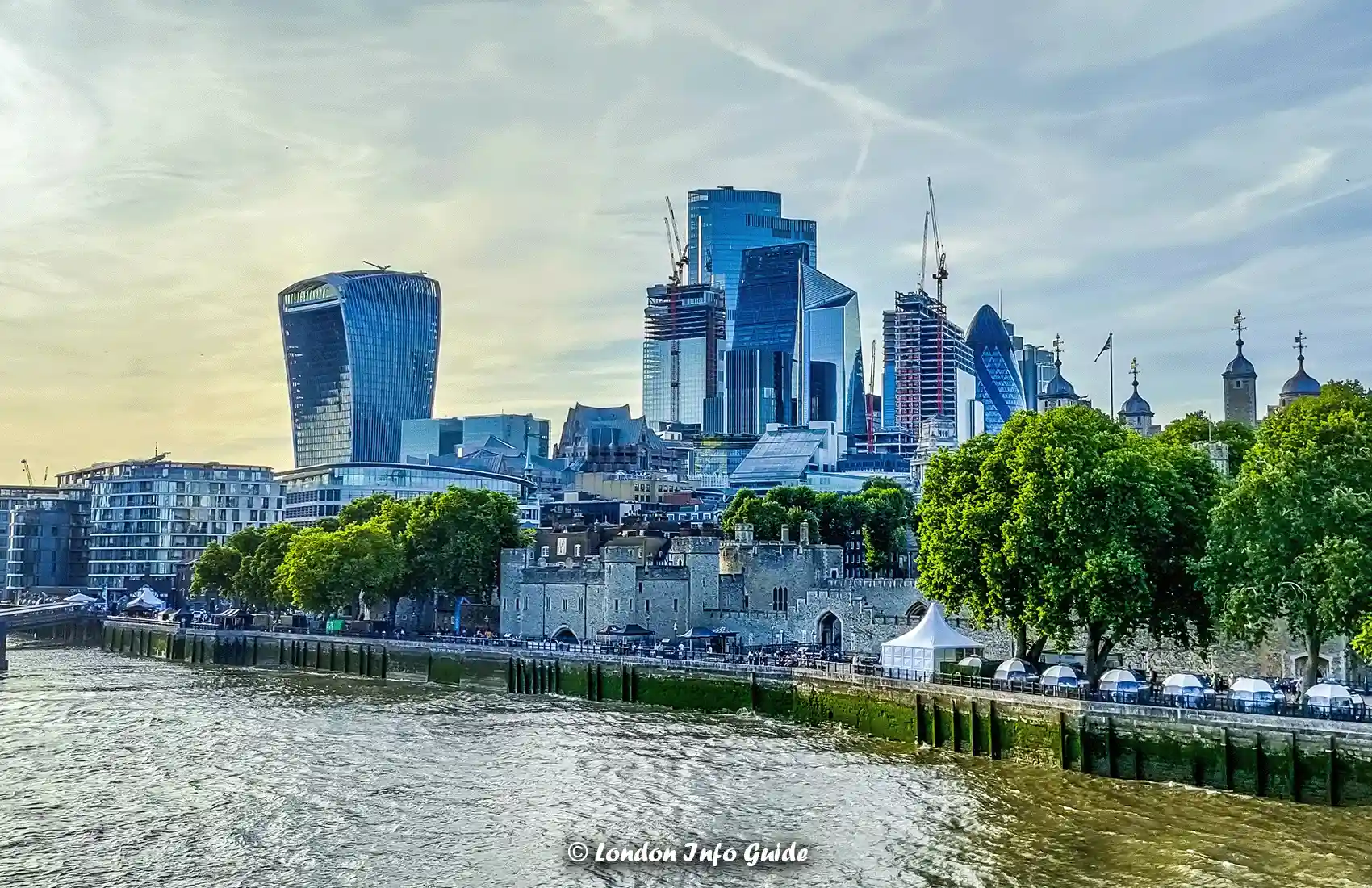 City of London from Tower Bridge
City of London from Tower BridgeHow To Get to The city of london
Since the City of London England is in the heart of Greater London, transportation is extremely easy to catch, and it is the city's financial district, which means many people commute to and from the area.
- Metro/Underground/Tube: There are several underground stations within the City of London boundaries namely Blackfriars, St. Paul's, Bank, Barbican, Cannon Street, Monument, Aldgate, Liverpool Street and Moorgate stations.
- Train Station: There are a few stations namely Blackfriars, Liverpool Street, Moorgate and Fenchurch.
- Buses: Several bus stops are placed across the entire district where a number of buses pass day and night.
- Taxi: They are found all over the district and you can book a taxi beforehand and they can pick you up anywhere.
- River Thames Transportation: Blackfriars Pier which is beside Blackfriars bridge and Millennium bridge.
the city of london england map
Below is a map pinpointing all the locations mentioned on this page for ease of reference when planning your visit to the City of London.
We have come to the end of our guide to the City of London England. Hopefully, this guide has provided you with a better understanding of this vibrant financial district. If you are visiting London, this is a location you won't want to miss.
common questions about the city of london
Where is the city of London on the map of London?
Where is the city of London on the map of London?
The City of London, also known as the "Square Mile," is located in the eastern part of the city. Historically, it serves as the city's financial and historical centre.
Which colours and symbols are present on the City of London flag?
Which colours and symbols are present on the City of London flag?
The city's flag is designed with a red cross and a central shield with a silver sword that is bordered by red uprights.
What distinguishes London vs. the City of London?
What distinguishes London vs. the City of London?
The historical financial centre known as the "Square Mile" is particularly referred to as the "City of London," while the term "London" refers to the larger metropolitan area that consists of 32 towns and suburbs.
What distinguishes the City of London from the City of Westminster?
What distinguishes the City of London from the City of Westminster?
London's City of Westminster is home to iconic landmarks like Buckingham Palace, Westminster Abbey, and the Houses of Parliament, which contribute significantly to London's cultural and political life. The City of London is a historical financial district with a distinct governance from the rest of London.
In the larger context of London, where is the City of London located?
In the larger context of London, where is the City of London located?
The 32 boroughs around the City of London, which is separate from Greater London, but it is not a part of them. It represents its historical centre and global financial prominence as a distinct organisation with distinctive governance.
Why do people sometimes refer to a location as "City of London, London, England"?
Why do people sometimes refer to a location as "City of London, London, England"?
By designating the City of London as unique within the larger context of England and the capital city, the phrase "City of London, London, England" enables accurate identification of a specific place inside London.
What is the "City of London population"?
What is the "City of London population"?
Why is the City of London often referred to as the "Square Mile"?
Why is the City of London often referred to as the "Square Mile"?
The City of London is referred to as "the Square Mile" in casual speech because of its tiny geographic area. This phrase has been historically used to highlight the district's significance as a financial and trading hub within this small area.
The boundaries include the River Thames to the south and the Barbican and Old Street area to the north. In the east and west, it does not have specific natural boundaries but is defined by places like the Tower of London and the Temple.
Area: 1.12 square miles or 716.80 acres or 2.90 square kilometres
What is the City of London Police's purpose and role in the City of London?
What is the City of London Police's purpose and role in the City of London?
The City of London Police is a separate law enforcement organisation tasked with maintaining order, safeguarding safety, and policing the City of London, particularly its financial centre.
Is the City of London considered a borough within London's administrative structure?
Is the City of London considered a borough within London's administrative structure?
Each London borough has its council responsible for providing local services within Greater London.
With its government and administration, the City of London is unique among the London boroughs because it serves as both a ceremonial county and a local authority.
In what ways does 'City of London Police' differ from other London law enforcement?
In what ways does 'City of London Police' differ from other London law enforcement?
Founded in 1839, the City of London Police is separate from the Metropolitan Police Service and has jurisdiction over the City of London. Several specialised divisions in the City of London provide financial fraud prevention, cybersecurity, and customized crime prevention services, such as the Economic Crime Directorate and Cyber Crime Unit.
Who holds authority and runs the City of London?
Who holds authority and runs the City of London?
As the local government and administration authority for the City of London, the Corporation is responsible for managing local affairs. It also provides local services and operates its own police force.
How did the City of London acquire its name?
How did the City of London acquire its name?
Londinium was the name given to the first settlement established by Roman legions around 43 AD. London's financial and historical centre is referred to as the "City", rather than the larger metropolitan region of Greater London.
Find The Best Places To Stay Nearby
This fantastic interactive map below helps you discover the best accommodation across London from a variety of trusted platforms. Explore different neighbourhoods, compare prices, and book directly all under one platform.
Want To Share This Page On Pinterest? Pin It Here!
photo and website sources
- Streets of the City of London England - Image by Kai Pilger from Pixabay
- St. Paul's Cathedral - Photo by Alex Tai on Unsplash
- Bishopsgate City of London - Photo by Frans Ruiter on Unsplash
- London's Financial District - Image by Albrecht Fietz from Pixabay
Website Sources:
- [1] City Bridge Foundation - About
- [2] City Of London - The City's Government
- [3] How life has changed in the City of London: Census 2021
- [4] The role of financial and professional services in the UK
